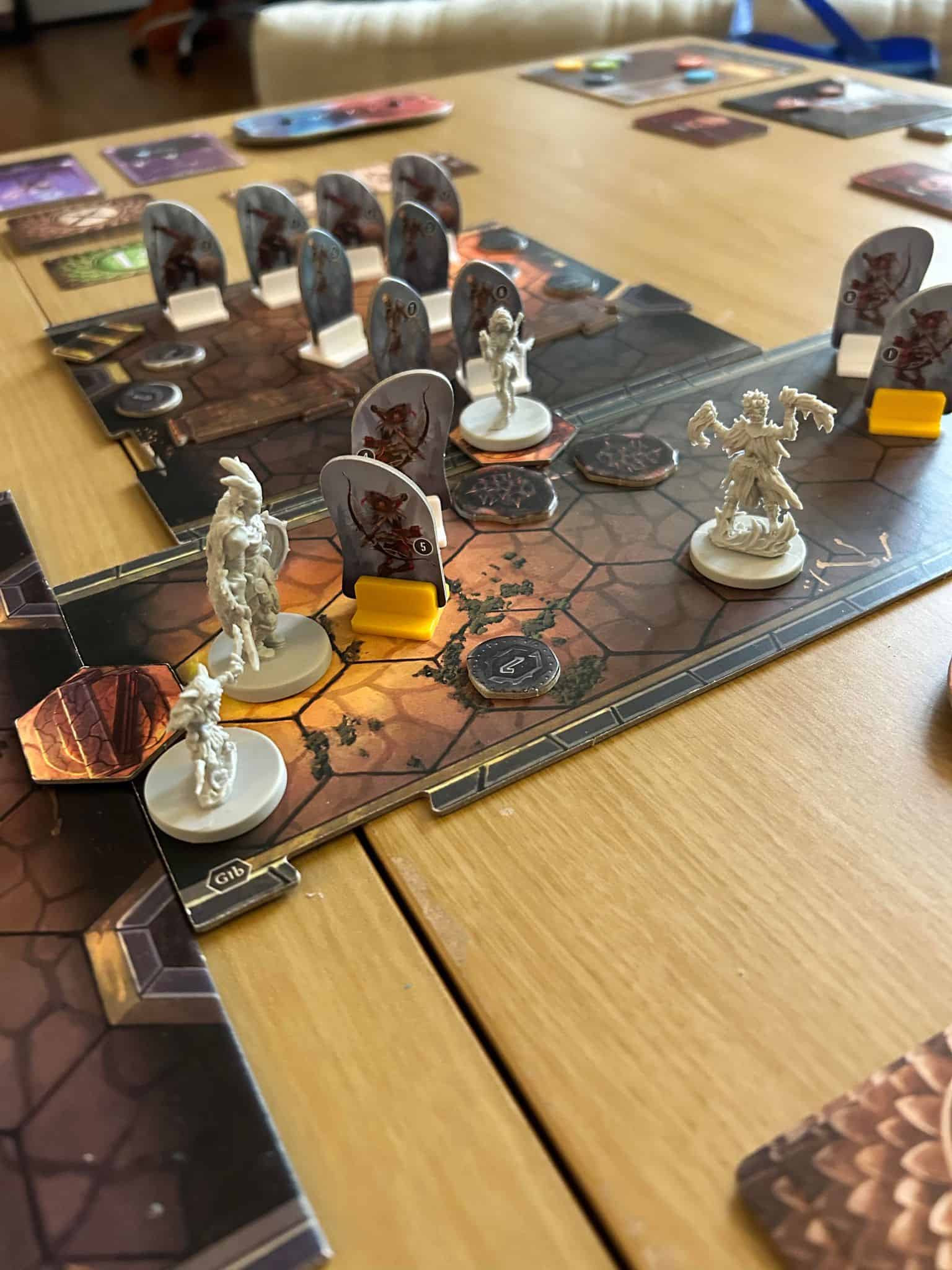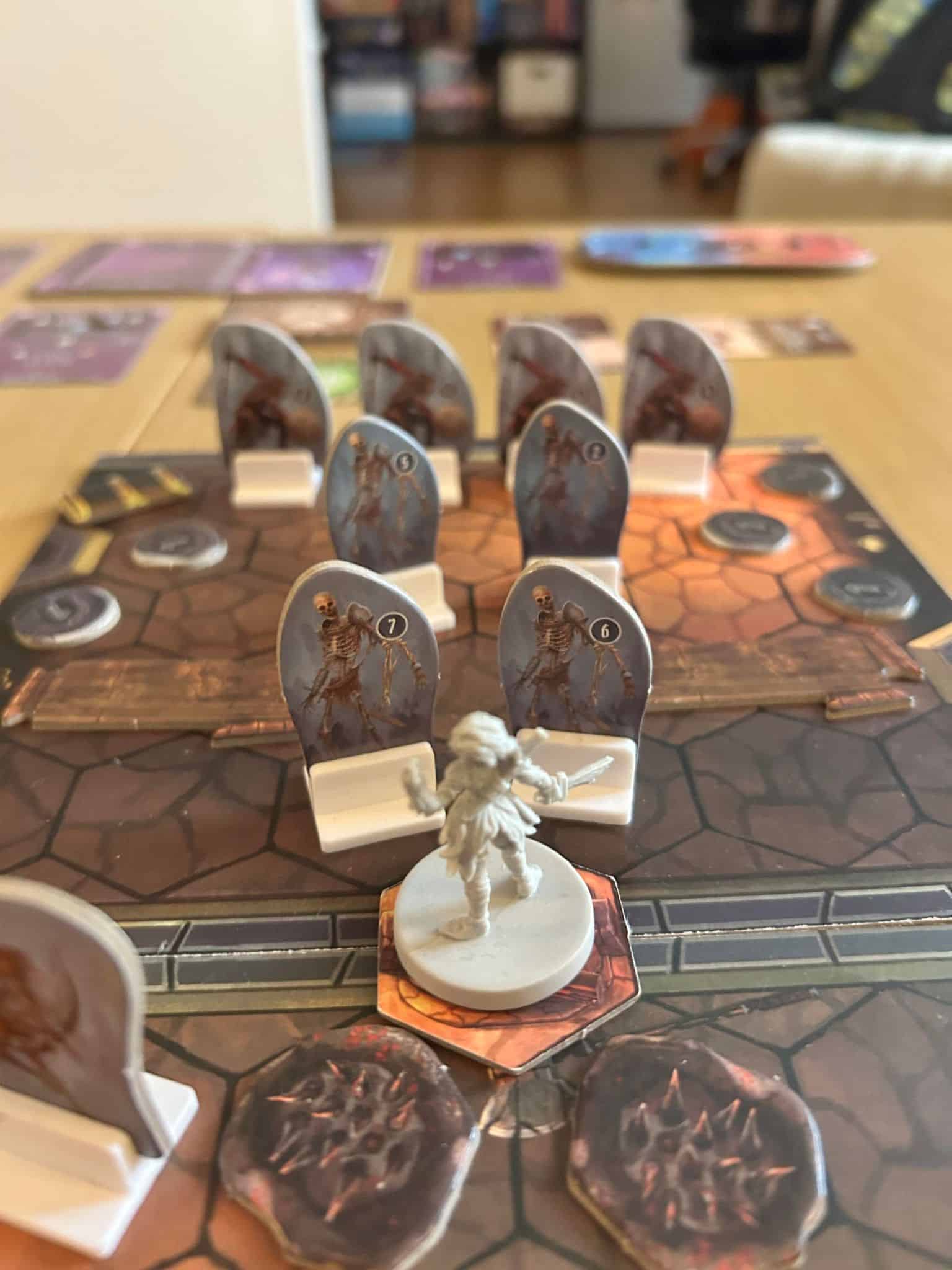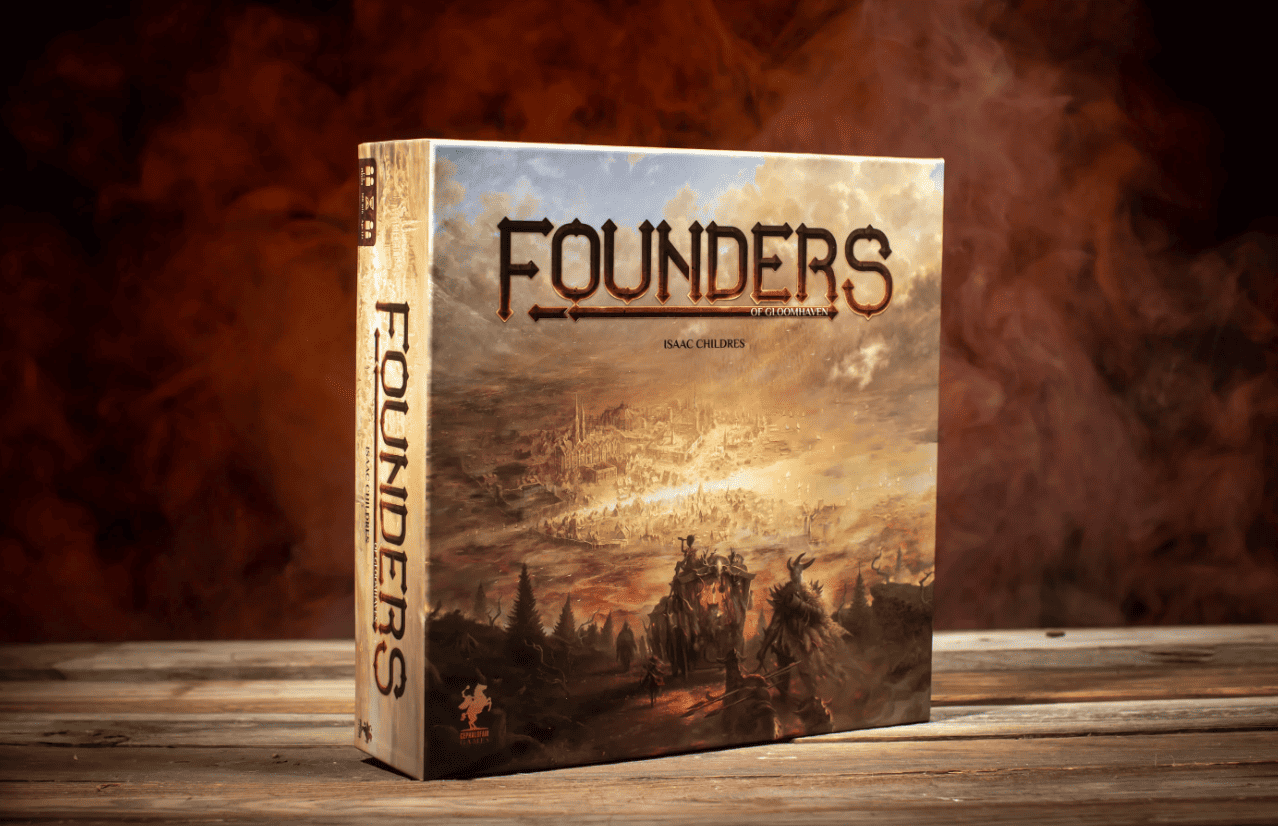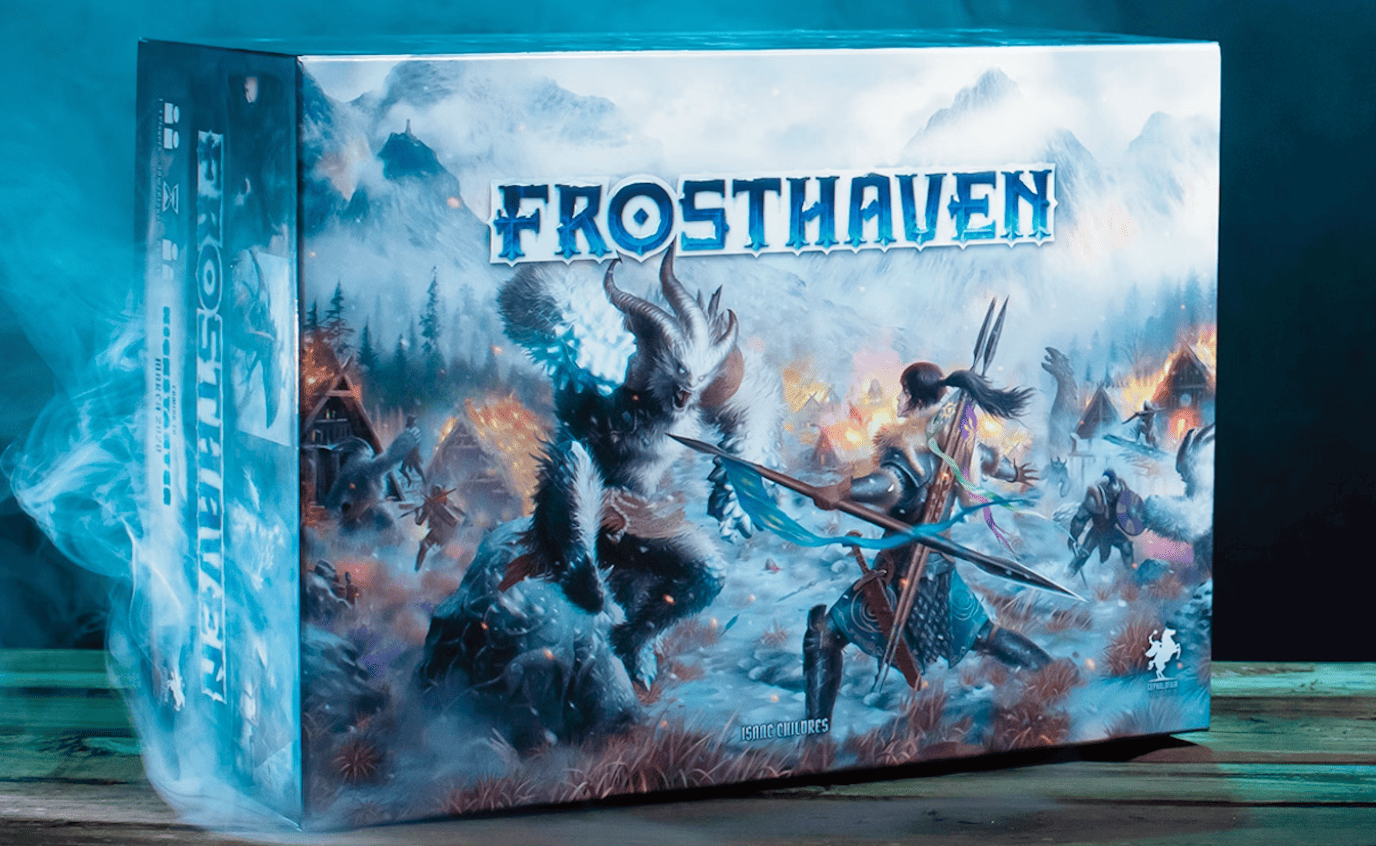You’ve seen the big box. Maybe it was weighing down a shelf in your local games store or hiding not-so-inconspicuously amongst a friend’s games collection. Gloomhaven is a beast of a game.
This campaign board game, first released via Kickstarter in 2017, has a cult following. If you’re trying to decide whether to fork out hundreds of pounds (or whatever your currency is, it’s a lot), this guide and review covers everything you need to know about Gloomhaven.
Gloomhaven: The Essentials
- Number of players: 1-4
- Time to play: 60-120 minutes
- Age of players: 14+
- Designer: Isaac Childres
- Publisher: Cephalofair Games
The ultimate campaign board game, Gloomhaven takes elements from dungeon crawler board games like Mage Knight and Descent and perfects them. Players use a slick hand management mechanic for combat and will watch their characters advance across levels and eventually retire from adventuring.
Gloomhaven could also be said to appeal to fans of roleplaying games like Dungeons & Dragons. While there’s no dice rolling here, Gloomhaven does offer a rich storyline that may take several weeks or months to finish with a regular group of players.
As a lengthy campaign board game, Gloomhaven requires a regular group of committed players to make purchasing it worthwhile. If you can pull together this kind of group, however, Gloomhaven is one of the best board games out there and worth every penny.
What’s in the Gloomhaven Box?

Books
- Rule book
- Scenario book
- Town Records book
Boards, Maps, and Tiles
- A campaign board showing the city of Gloomhaven and surrounding areas with spaces for global achievement stickers
- 30 2-sided map tiles
- 155 2-sided overlay tiles
- 17 character boards
- 4 HP/XP dials
- Element infusion board
Pieces and Tokens
- 17 character miniatures
- 240 monster standees
- 24 plastic stands (for standees)
- 6 wood element discs
- Round tracker
- 32 summon tokens
- 60 status tokens
- 85 character tokens
- 50 money tokens
- 46 damage tokens
- 10 scenario aid tokens
- 12 objective tokens
Cards
- 504 character ability cards
- 457 attack modifier cards
- 232 monster ability cards
- 47 monster stat sheets
- 6 monster stat sleeves
- 150 event cards
- 253 item cards
- 24 battle goals cards
- 24 personal quest cards
- 9 random scenario cards
- 40 random dungeon cards
- 4 player reference cards
Extras
- 35 character boxes
- 17 character pads
- A party pad
- 3 sealed envelopes
- 4 sticker sheets
How to Play Gloomhaven
Setup

Campaign Setup
- Choose your starting characters
-
- Each player chooses one of the available starting characters: Brute, Tinkerer, Spellweaver, Scoundrel, Cragheart, and Mindthief. The Brute, Spellweaver, and Scoundrel are a great group of starting characters for a game of three players.
- Take the corresponding character box, miniature, ability cards, character sheet, and other components from the chosen character’s box.
- Set up characters
-
- Players choose a name for their characters.
- Each player sets their character’s maximum hit points (based on level 1) on their hit point dial.
- Players start with a set of level 1 ability cards for their character. They can use a certain number of these cards (specified on the character mat) of their choice to form their hand for scenarios.
- Each character receives a personal quest card. This quest outlines the character’s overarching objective. Once completed, it typically leads to the character’s retirement.
- Each character starts with 30 gold.
- Initial City and Road events
-
- Shuffle the city event cards and draw one. Resolve the event. Some events might have repercussions or unlock new scenarios.
- Before heading to your first scenario, draw and resolve a road event.
- Set up and play the first scenario
-
- Begin with Scenario #1, Black Barrow. Follow the setup instructions as provided in the Scenario Book.
- After completing the first scenario, characters return to Gloomhaven where they may level up and buy new items.
- Continue the adventure!
- The Scenario Book will help you decide which scenario to take up next. Often, players have multiple choices and can collectively decide where to go.
- As you progress through the campaign, your characters will gain XP to level up and eventually retire. You’ll unlock new characters to play as too.
- You’ll keep track of your progress using stickers on the campaign board and using the party sheet, which tracks things like party achievements and reputation.
Scenario Setup
While different scenarios have different setups (all clearly explained in the Scenario book), a typical scenario setup will go like this:
- Select the scenario
-
- Decide on the scenario you’re playing based on your campaign progression or choose one for a standalone game. Reference the scenario book for details.
- Set up map and overlay tiles
-
- Identify the map tiles needed for the scenario from the scenario book.
- Lay out the tiles as illustrated in the book, connecting them as necessary.
- Based on the scenario’s diagram, place the corresponding overlay tiles onto the map tiles. This includes traps, obstacles, treasure chests, doors, and other special tiles.
- Ensure the placement matches the scenario’s specifics regarding which types of obstacles and traps to use.
- Place the element infusion board next to the map and reset all elements to “inert”.
- Have condition tokens, damage tokens, summon tokens, money tokens, and element tokens readily available.
- Set up monsters
-
- Identify which monsters will be present in the scenario.
- Set up the monster standees, ability cards, and stat sheets for each type. Only use the number of standees indicated by the scenario for your player count.
- Prepare their attack modifier deck.
- Place characters’ and monsters’ figures on the map tiles according to the scenario’s initial layout.
- Character setup
- Players select their ability cards for the scenario. Remember, characters have a specific maximum number of cards they can bring, based on their class and level.
- Set your character’s hit points and experience dials.
- Players select items they’ll use for the scenario, staying within their maximum item count.
- Shuffle the battle goal deck and deal two to each player. Each player secretly selects one as their goal for the scenario and returns the other.
How to Win Gloomhaven

Gloomhaven is a campaign board game, so “winning” the game involves winning lots of scenarios that complete an overarching narrative.
The win conditions for scenarios vary and out outlined in the scenario book under the scenario heading next to “Goal”, but the standard scenario goal is to kill all enemies. Some scenarios, particularly as the game progresses, have more complex goals. Characters may have to travel from one end of the map to another, protect an NPC, or retrieve items off the board.
Gameplay
1. Start of Round
- Card selection: Each player selects two cards from their hand to play for the round. These cards will determine your actions and initiative for the round.
- Determine initiative: Players reveal their selected cards, and the initiative is determined by the top-left number of the leftmost card. Lower numbers go first.
- Monster initiative is determined by the drawn monster ability card for that round.
- Players and monsters take their turns in order of initiative.
2. Player Turn
- Use the chosen cards’ abilities: Players must choose one top action and one bottom action from their two cards. They can decide on the order. Instead of the printed action, players can always choose to perform a default “Attack 2” for a top action or “Move 2” for a bottom action.
- Create or consume elements: Some abilities require or are enhanced by consuming available elements on the element infusion board. Some cards create these elements.
- Discard or lose cards: After using them, cards are either discarded or lost, as indicated by the symbols on the card. Lost cards cannot be recovered for the rest of the scenario (except through specific abilities).
- Use items: Players can use items at appropriate times on their turn, based on the item’s description.
- Short rest: Players can choose to do a short rest at the end of their turn if they’ve played all their cards. This allows them to regain discarded cards at the cost of permanently losing one (at random) for the rest of the scenario.
3. Monster Turn
Monsters act based on the ability card drawn for them at the beginning of the round:
- Follow card instructions: Monsters will move, attack, or perform special actions as indicated.
4. End of Round
- Move element tokens: On the element infusion board, move all “Strong” elements to “Waning” and all “Waning” elements to “Inert”.
- Reset and prepare for the next round: Players pick up their chosen cards for the round and decide on the next set of cards to play.
5. End of Scenario
The scenario ends when:
- Goal achieved: Players achieve the scenario’s goal.
- All characters exhausted: If all players become exhausted (either by losing all health or being unable to play two cards at the start of a round), the scenario is lost.
- Other conditions: Some scenarios may have unique end conditions, specified in the Scenario book.
My Review of Gloomhaven

- Overall gameplay: 9/10
- Replayability: 10/10
- Artwork and components: 9/10
Pros
- Excellent narrative and worldbuilding
- High replayability value
- Slick and strategic gameplay
Cons
- Expensive
- Long setup and teardown time
- Requires a consistent, regular group
It was a cold, gloomy week in January and I along with two friends had travelled to the Lake District for our annual walking-meets-gaming holiday. The timing was perfect for our first game, or games, of Gloomhaven — Isaac Childres’ iconic campaign board game that has since inspired a digital adaptation and even a full-blown sequel game, Frosthaven.
Playing Gloomhaven during a week we had already dedicated to gaming was ideal, since this campaign game requires time and commitment from you and your fellow players. At the time, we were all living in York, England, and so even after the holiday we were able to come together a few nights a week and play Gloomhaven, eventually seeing it through to its grand conclusion. Since then, we’ve all moved to separate places and when Frosthaven finally arrived, getting together on a regular basis to play through the much-awaited sequel was sadly impossible.
What did we love so much about Gloomhaven? Gloomhaven is a rich campaign board game. While I’ve played other campaign games like Mice and Mystics and Betrayal Legacy, the sheer volume of content, branches of choices, and richness of story set Gloomhaven apart from its rivals. This is no standard legacy game but a full-fledged adventure campaign in which you’ll customise your characters and make choices that will affect the plot.
Gloomhaven is made up of many ‘scenarios’, during which you will set up a board full of monsters, traps, and treasure, and work with your fellow players to beat the scenario, usually by killing all monsters on the board. Each character has its own deck of cards, which grows as you level up. In a round, you play two cards from your hands, using the top action of one and the bottom action of the other. These cards allow you to attack, cast spells, move, and do other cool, character-specific things to help you win the scenario. This means that Gloomhaven is also a card management game with plenty of strategy. With each new scenario being a brand new addition to the narrative, with a new map and often new goals, Gloomhaven has excellent replayability.
Outside of scenarios, you’ll complete road and city events, which may affect your party’s reputation, leading to future consequences (good and bad). You’ll also buy items from the shop to aid in battle. Reading these rules, you may be struck by the overlaps between Gloomhaven and roleplaying games like Dungeons & Dragons. While of course not offering the same level of autonomy and personalisation that a D&D campaign can offer, Gloomhaven is, in my opinion, the closest a board game gets to recreating the narrative-driven adventuring and excitement of D&D.
Like a D&D campaign, Gloomhaven is plagued by the curse of player availability. While random dungeons can be generated for one-off games, the campaign requires over 100 hours of gameplay. That means you need a regular group who are committed to months of gaming to work through this campaign. It’s certainly worth it, but not every gamer has such a group.
Even if you do manage to get your group around the table every week to play Gloomhaven, you’ll be asking them to commit to several hours per game. Gloomhaven has a long setup and teardown time and a scenario can take two hours or more.
Some gamers will also find the price point offputting. In the U.K., a copy of Gloomhaven can cost £100-200. If you don’t manage to pull a group together to play often enough, that’s a huge expense for a game that only gathers dust.
If you can put together a committed group, however, the cost is worth it. Those 100 hours plus of gaming is enough to cover two or three regular board games and here you get a full narrative to engage in. Casual gamers may not get to experience Gloomhaven for what it’s worth, but those prepared to commit to its campaign will find it highly rewarding. Gameplay is slick, original, and engaging and the cast of characters, storylines, and twists and turns created a memorable experience for me and my friends that I’ll always look back on fondly.
The Gloomhaven Universe: Expansions and Sequels
Forgotten Circles

- What is it?: An expansion for the Gloomhaven base set that adds new scenarios and a new character to play as.
- Number of players: 1-4
- Time to play: 60-120 minutes
- Age of players: 14+
Forgotten Circles is an expansion or, rather, an extension of Gloomhaven, as it adds new scenarios taking place after the completion of the original narrative. You can pick up old characters or create new ones, but one player must play as the Diviner, a new character created for this game. Forgotten Circles adds 20 new scenarios, so plenty of gameplay. Many of these scenarios are more puzzle-based rather than simply ‘kill all enemies’.
Should you buy Forgotten Circles?: If you’ve finished the base Gloomhaven game and you’re hungry for more (and if unusual, puzzle scenarios appeal to you), then yes.
Jaws of the Lion

- What is it?: A standalone prequel to Gloomhaven aimed at new players or anyone considering buying Gloomhaven.
- Number of players: 1-4
- Time to play: 30-120 minutes
- Age of players: 14+
Jaws of the Lion offers a new campaign of 25 scenarios set in the city of Gloomhaven. It’s a streamlined and more accessible board game in comparison to Gloomhaven, and one of the most notable changes is the shift from modular board pieces to a scenario book that players play on directly, reducing setup and teardown time.
Should you buy Jaws of the Lion?: If you’re considering buying Gloomhaven, but want to try out a more compact version well-suited to new players, yes. If you’ve already played Gloomhaven, you might find Jaws of the Lion a less dynamic and exciting game.
Founders of Gloomhaven

- What is it?: An standalone city-builder board game about the building of the city of Gloomhaven.
- Number of players: 1-4
- Time to play: 90-120 minutes
- Age of players: 12+
Founders of Gloomhaven chronicles the establishment and growth of the iconic city of Gloomhaven long before the events of the original game. Players represent different races working to build the city and gain influence over its development. They must collaborate to create resource chains but compete to have the most influence over the completed city. The game combines tile placement, action selection, hand management, and city-building mechanics.
Should you buy Founders of Gloomhaven?: While fans of Gloomhaven will enjoy the setting, Founders is a pretty weak board game, especially compared to the other games of its kind out there like Above and Below and Charterstone. I find the mechanics clunky and unintuitive, so no I would not recommend this board game.
Gloomhaven Digital
- What is it?: A digital adaptation of Gloomhaven
- Number of players: Single-player or online co-op
- Platforms: Windows and Mac (due to be ported to Switch, PS4, PS5, XBox One, and XBox Series X/S in 2023)
Gloomhaven Digital is, quite simply, an online video game version of Gloomhaven. The rules and scenarios are identical and this game allows players to play through Gloomhaven with a digital map and pieces. This solves some of the problems outlined in my review, like long setup and teardown times (everything is automated on Gloomhaven Digital) and player availability, since getting together online is often easier than in person.
Should you buy Gloomhaven Digital?: If digital renderings of board games are your thing, why not! Gloomhaven Digital works well on PC and isn’t too buggy, with regular updates too. It can’t replace the fun of in-person gaming, but this is a solid digital rendering.
Frosthaven

- What is it?: An standalone sequel to Gloomhaven set in a new, northern setting.
- Number of players: 1-4
- Time to play: 30-120 minutes
- Age of players: 14+
Set in the harsh, frozen lands to the north of Gloomhaven, players take on the roles of mercenaries trying to protect the outpost of Frosthaven. The game presents new challenges with its seasonal effects, resource gathering, and town-building mechanics. With 16 new characters, over 100 scenarios, and new items, events, and mechanics, Frosthaven offers a fresh yet familiar experience for Gloomhaven fans.
Should you buy Frosthaven?: Yes! Playing Frosthaven for the first time recently, I could see how it improved upon the base mechanics of Gloomhaven and makes for an even richer and slicker game. Classes are exciting to play with and the new mechanics around managing the city and winter conditions are a welcome added layer of complexity. I had high expectations and Frosthaven exceeded them.
Conclusion

I’ve been playing board games for a long time, but Gloomhaven is one that sticks out and really raised the bar for what board games can do. With a full narrative containing branches based on player choices, exciting combat, and fun characters, Gloomhaven is, in my opinion, one of the best games out there. While not for gamers shy of long campaigns or with minimal table space, Gloomhaven can create a long-lasting and rewarding experience for you and your fellow gamers if you put the time into it.
Frequently Asked Questions
Question: Why is Gloomhaven so expensive?
Answer: Gloomhaven offers at least 100 hours of gameplay, all of which is original since you’re working through a campaign of unique scenarios. Full of excellent components, a rich story-driven narrative, and slick gameplay, Gloomhaven is, in my opinion, worth the cost.
Question: Can you play Gloomhaven with one character?
Answer: Yes! Gloomhaven has a solo mode with slightly adjusted mechanics.
Question: What age is Gloomhaven suitable for?
Answer: Gloomhaven’s suggested age range is 14+. Combat is complex and requires good understanding by every player.
- Everdell Board Game Guide and Review - August 30, 2023
- Root Board Game Guide and Review - August 17, 2023
- Gloomhaven Board Game Guide and Review - August 16, 2023

